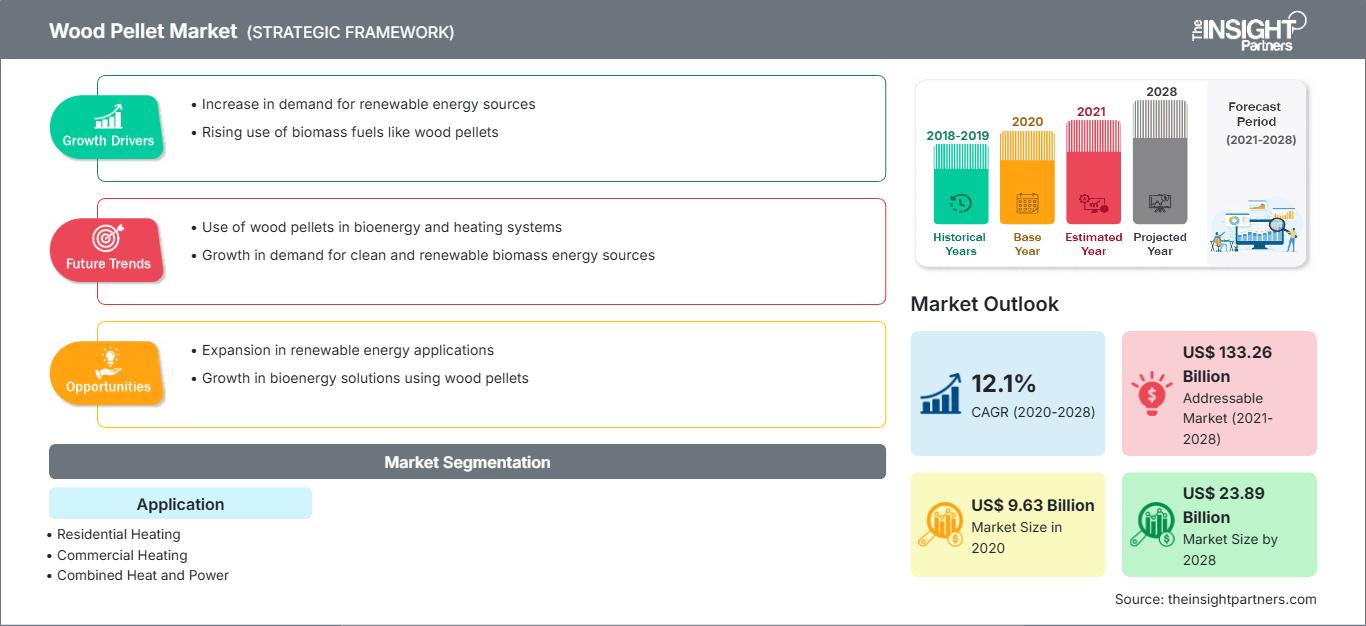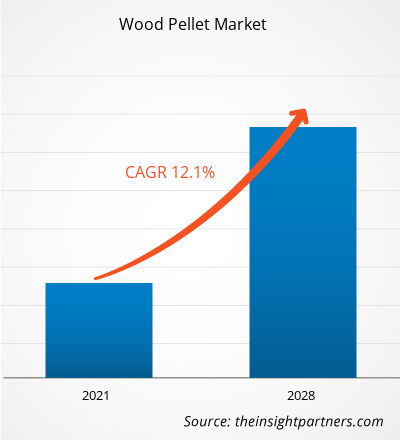Il mercato dei pellet di legno è stato valutato a 9.630,99 milioni di dollari nel 2020 e si prevede che raggiungerà i 23.892,77 milioni di dollari entro il 2028; si prevede una crescita a un CAGR del 12,1% dal 2021 al 2028.
I pellet di legno sono prodotti utilizzando corteccia di legno finemente macinata; sono utilizzati principalmente come combustibile. Sono ampiamente utilizzati nelle abitazioni per una combustione efficiente in stufe di piccole dimensioni. I pellet di legno sono prodotti da numerosi scarti di legno e sono considerati una fonte di energia rinnovabile. Attualmente, oltre al riscaldamento residenziale, l'uso di pellet di legno per la produzione di energia è in aumento in tutto il mondo. Questi sono ampiamente utilizzati a livello globale come combustibile, il che dovrebbe aumentare la domanda di pellet di legno nei prossimi anni. L'Europa è la regione leader per il consumo di pellet di legno per la produzione di energia. Inoltre, il Nord America è un importante esportatore di pellet di legno, il che dovrebbe aumentare gli impianti di produzione di pellet di legno nei prossimi anni.
Nel 2020, l'Europa ha contribuito alla quota maggiore del mercato globale. Un rapporto annuale depositato presso il Global Agriculture Information Network dell'USDA Foreign Agricultural Service indica che il mercato del pellet di legno in Europa è stato relativamente poco influenzato dalla pandemia di COVID-19. Secondo il rapporto, la regione ha consumato circa 29 milioni di tonnellate di pellet di legno nel 2018, il che la rende il più grande mercato di pellet al mondo. I pellet di legno sono utilizzati in applicazioni residenziali per il riscaldamento e per la produzione di calore ed energia industriale. Il rapporto afferma inoltre che la regione contribuisce attualmente a circa il 30% della produzione mondiale di pellet. Tuttavia, rappresenta il principale consumo di pellet di legno a livello globale. Italia, Germania e altri paesi simili sono considerati i principali mercati in crescita per il consumo di pellet di legno nelle applicazioni di riscaldamento residenziale. Il Regno Unito è uno dei principali consumatori di pellet di legno, seguito da Italia e Danimarca.
Il mercato globale del pellet di legno ha dovuto affrontare numerose sfide a causa dell'impatto dell'epidemia di COVID-19. L'attuale pandemia di COVID-19 ha drasticamente alterato lo stato del settore chimico e dei materiali e ha avuto un impatto negativo sulla crescita del mercato del pellet di legno. L'attuazione di misure per contrastare la diffusione del virus ha aggravato la situazione e ha influenzato la crescita di diversi settori industriali. Il mercato è stato colpito dall'improvvisa distorsione dell'efficienza operativa e dalle interruzioni nelle catene del valore attribuibili alla chiusura improvvisa dei confini nazionali e internazionali. Le interruzioni nell'approvvigionamento di materie prime dai fornitori e le chiusure temporanee degli stabilimenti produttivi dovute a lockdown a tempo indeterminato e quarantene temporanee hanno avuto un impatto sulla crescita del mercato durante la pandemia. Secondo una notizia pubblicata da Woodcote Media Ltd il 30 luglio 2020, un'indagine condotta da ENplus, un sistema di certificazione per il pellet di legno, ha rilevato che il 75% dei produttori certificati ha subito un impatto negativo a causa della pandemia di COVID-19. Le aziende stanno pianificando di rivedere i prezzi del pellet di legno per i consumatori finali. Tuttavia, lo stesso rapporto ha evidenziato che circa il 5% degli intervistati ritiene che vi sia un leggero aumento della domanda di pellet di legno da parte dei consumatori finali. Analogamente, la filiera del legno è stata colpita dalla pandemia, che ha causato interruzioni nell'approvvigionamento delle materie prime e nei prezzi.
Personalizza questo rapporto in base alle tue esigenze
Potrai personalizzare gratuitamente qualsiasi rapporto, comprese parti di questo rapporto, o analisi a livello di paese, pacchetto dati Excel, oltre a usufruire di grandi offerte e sconti per start-up e università
Mercato dei pellet di legno: Approfondimenti strategici

- Ottieni le principali tendenze chiave del mercato di questo rapporto.Questo campione GRATUITO includerà l'analisi dei dati, che vanno dalle tendenze di mercato alle stime e alle previsioni.
Approfondimenti di mercato: crescente consapevolezza sull'uso di fonti energetiche rinnovabili
Potrai personalizzare gratuitamente qualsiasi rapporto, comprese parti di questo rapporto, o analisi a livello di paese, pacchetto dati Excel, oltre a usufruire di grandi offerte e sconti per start-up e università
Mercato dei pellet di legno: Approfondimenti strategici

- Ottieni le principali tendenze chiave del mercato di questo rapporto.Questo campione GRATUITO includerà l'analisi dei dati, che vanno dalle tendenze di mercato alle stime e alle previsioni.
Le energie rinnovabili svolgono un ruolo fondamentale nel soddisfare il futuro fabbisogno energetico sia nelle aree rurali che urbane. La scarsità di risorse, insieme alla crescente consapevolezza degli impatti ambientali negativi di prodotti e processi basati sui combustibili fossili, ha aumentato la dipendenza da fonti di energia rinnovabili come i pellet di legno. La crescente necessità di uno sviluppo energetico sostenibile è un ulteriore fattore che contribuisce all'aumento della domanda di pellet di legno. Le risorse e le tecnologie energetiche rinnovabili sono considerate alternative ecocompatibili in quanto generalmente causano un impatto limitato o nullo sull'ambiente rispetto ad altre fonti energetiche. Inoltre, tali risorse sono facilmente disponibili e non possono essere esaurite.
I pellet di legno sono classificati tra le fonti di energia rinnovabili in quanto derivati dagli alberi e sono una forma di biomassa. I pellet di legno sono composti da fibre di legno essiccate e compresse, ricavate da residui di segheria, detriti di disboscamento come cumuli di detriti forestali e tronchi interi. Secondo l'Energy Information Administration statunitense, la biomassa è classificata come materiale organico che può essere efficacemente utilizzato come fonte di energia. Diverse forme di biomassa, come i pellet di legno, sono a zero emissioni di carbonio e lasciano un'impronta di carbonio netta pari a zero durante la combustione della biomassa.
Approfondimenti
In base all'applicazione, il mercato globale dei pellet di legno è segmentato in riscaldamento residenziale, riscaldamento commerciale, cogenerazione (CHP) e produzione di energia elettrica. Il segmento del riscaldamento residenziale ha guidato il mercato globale dei pellet di legno nel 2020. I sistemi alimentati a legna sono comunemente utilizzati in tutto il mondo per il riscaldamento residenziale e recentemente i pellet di legno hanno sostituito la tradizionale legna da ardere. Le caldaie a pellet di legno per applicazioni di riscaldamento residenziale promettono basse emissioni, elevata efficienza e funzionamento automatico. I pellet di legno vengono utilizzati per il riscaldamento residenziale nelle stufe a pellet. Vengono inoltre utilizzati nelle caldaie a pellet per generare calore, vapore ed elettricità nel settore dei servizi, nella produzione di energia e nel settore manifatturiero. Vengono utilizzati per la produzione di energia e calore nei settori manifatturiero ed energetico, trainando il mercato dei pellet di legno. Poiché il costo del pellet di legno è rimasto a lungo inferiore a quello di altri combustibili, esso rappresenta un'opzione più economica, rispondendo alla principale preoccupazione del settore residenziale. In quanto fonte di energia rinnovabile, il pellet di legno ha ricevuto incentivi e sussidi dai governi di diversi paesi. Negli ultimi anni, molti paesi hanno lanciato o aggiornato le proprie politiche e programmi relativi al pellet di legno per applicazioni di riscaldamento.
Tra i principali attori del mercato del pellet di legno figurano Pacific BioEnergy, Premium Pellet Ltd., Pinnacle Renewable Energy, Enviva, ANDRITZ, Wood & Sons, Graanul Invest, New England Wood Pellet, TANAC ed Energex Pellet Fuel, Inc.
In evidenza nel rapporto
- Tendenze progressive del settore nel mercato globale dei pellet di legno per aiutare gli operatori a sviluppare strategie efficaci a lungo termine
- Strategie di crescita aziendale adottate dai mercati sviluppati e in via di sviluppo
- Analisi quantitativa del mercato globale dei pellet di legno dal 2019 al 2028
- Stima della domanda del mercato dei pellet di legno in vari settori
- Analisi PEST per illustrare l'efficacia di acquirenti e fornitori che operano nel settore nel prevedere la crescita del mercato
- Sviluppi recenti per comprendere lo scenario competitivo del mercato e la domanda di pellet di legno
- Tendenze e prospettive di mercato, insieme ai fattori che guidano e frenano la crescita del mercato dei pellet di legno
- Processo decisionale attraverso la comprensione delle strategie che sostengono l'interesse commerciale per quanto riguarda la crescita del mercato globale dei pellet di legno
- Dimensioni del mercato dei pellet di legno in vari nodi di mercato
- Panoramica dettagliata e segmentazione del mercato globale dei pellet di legno, nonché le sue dinamiche nel settore
- Dimensioni del mercato dei pellet di legno in varie regioni con promettenti opportunità di crescita
Approfondimenti regionali sul mercato dei pellet di legno
Le tendenze regionali e i fattori che influenzano il mercato dei pellet di legno durante il periodo di previsione sono stati ampiamente spiegati dagli analisti di The Insight Partners. Questa sezione analizza anche i segmenti e la geografia del mercato dei pellet di legno in Nord America, Europa, Asia-Pacifico, Medio Oriente e Africa, America Meridionale e Centrale.
Ambito del rapporto sul mercato dei pellet di legno
| Attributo del rapporto | Dettagli |
|---|---|
| Dimensioni del mercato in 2020 | US$ 9.63 Billion |
| Dimensioni del mercato per 2028 | US$ 23.89 Billion |
| CAGR globale (2020 - 2028) | 12.1% |
| Dati storici | 2018-2019 |
| Periodo di previsione | 2021-2028 |
| Segmenti coperti |
By Applicazione
|
| Regioni e paesi coperti | Nord America
|
| Leader di mercato e profili aziendali chiave |
|
Densità degli operatori del mercato dei pellet di legno: comprendere il suo impatto sulle dinamiche aziendali
Il mercato dei pellet di legno è in rapida crescita, trainato dalla crescente domanda da parte degli utenti finali, dovuta a fattori quali l'evoluzione delle preferenze dei consumatori, i progressi tecnologici e una maggiore consapevolezza dei vantaggi del prodotto. Con l'aumento della domanda, le aziende stanno ampliando la propria offerta, innovando per soddisfare le esigenze dei consumatori e sfruttando le tendenze emergenti, alimentando ulteriormente la crescita del mercato.

- Ottieni il Mercato dei pellet di legno Panoramica dei principali attori chiave
- Per applicazione, il mercato globale dei pellet di legno è segmentato in riscaldamento residenziale, riscaldamento commerciale, cogenerazione (CHP) e generazione di energia.
Profili aziendali
- Pacific BioEnergy
- Premium Pellet Ltd.
- Pinnacle Renewable Energy
- Enviva
- ANDRITZ
- Wood & Sons
- Graanul Invest
- New England Wood Pelletv5/8520
- TANAC
- Energex Pellet Fuel, Inc.
- Analisi storica (2 anni), anno base, previsione (7 anni) con CAGR
- Analisi PEST e SWOT
- Valore/volume delle dimensioni del mercato - Globale, Regionale, Nazionale
- Industria e panorama competitivo
- Set di dati Excel
Report recenti
Rapporti correlati
Testimonianze
Motivo dell'acquisto
- Processo decisionale informato
- Comprensione delle dinamiche di mercato
- Analisi competitiva
- Analisi dei clienti
- Previsioni di mercato
- Mitigazione del rischio
- Pianificazione strategica
- Giustificazione degli investimenti
- Identificazione dei mercati emergenti
- Miglioramento delle strategie di marketing
- Aumento dell'efficienza operativa
- Allineamento alle tendenze normative




















 Ottieni un campione gratuito per - Mercato dei pellet di legno
Ottieni un campione gratuito per - Mercato dei pellet di legno